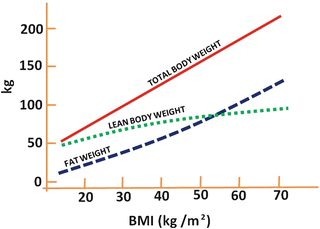Body composition of the obese is vastly different from their normal weight counterparts (Fig. 23.1). With increasing obesity, fat mass will increase at a greater rate than lean body weight. In other words, an obese person will have a greater fat mass, but only slightly more muscle mass than a normal weight individual of the same height and sex.


Fig. 23.1
Relationship between total body weight, lean body weight and fat weight to body mass index, in a standard height male (With permission from Oxford Publishers, BJA 2010;105(S1):i16–i23)
Total body weight (TBW) is the sum of lean body mass (LBM) and fat mass. Most drug doses recommended by the manufacturer are based on TBW.
LBM is accurately determined using dual energy x-ray absorptiometry (DEXA) but is more practically estimated from TBW by using the following formulas:-

 Ideal body weight (IBW) was introduced by Devine in 1974 to better predict the clearance of certain drugs in the obese. He estimated IBW according to the following formulas:-
Ideal body weight (IBW) was introduced by Devine in 1974 to better predict the clearance of certain drugs in the obese. He estimated IBW according to the following formulas:-
![$$ \begin{array}{ccc}\hfill \mathrm{F}\mathrm{o}\mathrm{r}\ \mathrm{males}\hfill & \hfill \hfill & \hfill 50 + 2.3\left(\mathrm{Height}\ \left[\mathrm{Inches}\right]-60\right)\hfill \end{array} $$](/wp-content/uploads/2016/09/A321497_1_En_23_Chapter_Equc.gif)
![$$ \begin{array}{ccc}\hfill \kern1.36em \mathrm{F}\mathrm{o}\mathrm{r}\ \mathrm{females}\hfill & \hfill \hfill & \hfill 45.5 + 2.3\left(\mathrm{Height}\ \left[\mathrm{Inches}\right]-60\right)\hfill \end{array} $$](/wp-content/uploads/2016/09/A321497_1_En_23_Chapter_Equd.gif) Administration of certain drugs based on TBW in the obese may result in toxicity. On the other hand, dosing based on LBM or IBW may result in under dosing for some drugs. Understanding how the drugs distribute in the body and using the correct weight descriptor will be the key to safely adapting drug doses in this population.
Administration of certain drugs based on TBW in the obese may result in toxicity. On the other hand, dosing based on LBM or IBW may result in under dosing for some drugs. Understanding how the drugs distribute in the body and using the correct weight descriptor will be the key to safely adapting drug doses in this population.


![$$ \begin{array}{ccc}\hfill \mathrm{F}\mathrm{o}\mathrm{r}\ \mathrm{males}\hfill & \hfill \hfill & \hfill 50 + 2.3\left(\mathrm{Height}\ \left[\mathrm{Inches}\right]-60\right)\hfill \end{array} $$](/wp-content/uploads/2016/09/A321497_1_En_23_Chapter_Equc.gif)
![$$ \begin{array}{ccc}\hfill \kern1.36em \mathrm{F}\mathrm{o}\mathrm{r}\ \mathrm{females}\hfill & \hfill \hfill & \hfill 45.5 + 2.3\left(\mathrm{Height}\ \left[\mathrm{Inches}\right]-60\right)\hfill \end{array} $$](/wp-content/uploads/2016/09/A321497_1_En_23_Chapter_Equd.gif)
Body Composition and the Impact on Pharmacokinetics
Body composition, although changed in the obese, affects only certain pharmacokinetic parameters. This is mainly in the way drugs are distributed.
Absorption
Oral drug absorption is not altered by obesity. Lipophilic drugs may take longer to reach steady state than hydrophilic ones as there is increased fat mass, taking these drugs longer to saturate the fat compartment.
Subcutaneous and intramuscular routes of administration may have an unpredictable effect in the obese. There may be differences in blood flow to the skin and drugs intended to be intramuscular may be deposited subcutaneously due to insufficient needle length.
Distribution of Drugs
The difference in body composition will influence distribution of many drugs at equilibrium. Initial distribution of intravenous drugs will not be much different than a normal weight individual as this depends on the cardiac output. All intravenous drugs will be distributed rapidly to the major organs and muscle mass.
After redistribution, lipophilic drugs tend to accumulate in the fat mass. As a result, volume of distribution (Vd) for lipophilic drugs will increase in the obese. The loading dose of these drugs should therefore be based on TBW.
Stay updated, free articles. Join our Telegram channel

Full access? Get Clinical Tree


